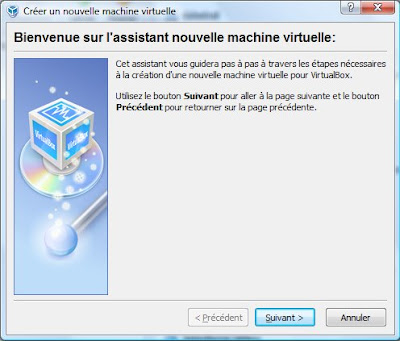Virtual Box is another Sun's amazing open-source product that basically creates a virtual computer within you real operating system. The product exists for either Linux or Windows platform and can be used to set up any major Linux distribution and Windows for desktop or server purpose. The greatest advantage of virtualization is hardware ressource saving for organisations. But for individual user, it offers the advantages of using 2 operating systems in the same computer without the need to format and partition your hard drive and all the other small configuration issues of dual booting without the need to format your main hard drive. You also have the possibility to install several instances of an operating system, or different operating systems which can be tricky (or even impossible?) in multi booting.
My goal in this tutorial is to show how to set up Linux Ubuntu 8.04 under Windows Vista Home Premium Edition.
1 - Setup Virtual Box
This process is straightforward and does not deserve to be detailed here. The installation file can be downloaded here.
2 - Create a new Virtual Machine
Click New (Nouveau) to launch the New Virtual Machine Wizard.
 Give a name to your new VM (as you give a name to your computer when setting up Windows).
Give a name to your new VM (as you give a name to your computer when setting up Windows).
The drop-down list box shows all the supported operating systems. The following window asks you to give a size to your memory.
You need to consider though that the amount of memory you give to your Virtual Machine will not be available to your host operating system anymore. On the other hand, you should give to your Operating System enough memory for it to work properly, Windows Vista as a guest for example, will require 512 Mb of memory at least.
The next step asks you to a new boot disk, with a recommanded minimum size of 8192 Mo. Click New.

Another wizard will help you to create a new virtual disk. The next window will ask you to choose between creating dynamic size virtual disk or a fixed size virtual disk. The dynamic size has a minimum size of 2 Gb and grows as it is filled with data. This option is recommanded if you want to save space on your physical hard drive.
 You give a name to your virtual hard drive and use a slider to assign a minimum size. Then, you specify the path you want your image file being saved in. Virtual Machine will start to create the image file. I use 20 Gb for the size of the virtual hard drive.
You give a name to your virtual hard drive and use a slider to assign a minimum size. Then, you specify the path you want your image file being saved in. Virtual Machine will start to create the image file. I use 20 Gb for the size of the virtual hard drive.

You can create as many virtual disk as you like. But like memory, the disk space you use to create a virtual disk will not be available to your host operating system anymore. The next window appears when Virtual Box has done created a virtual hard drive.

From there, you can create other hard drive by clicking new, or clicking Existing to select other available virtual hard drives to be used as a primary master. The last window is a summary of your virtual machine instance configuration. You can later change the size of your memory and many other parameters.


No comments:
Post a Comment